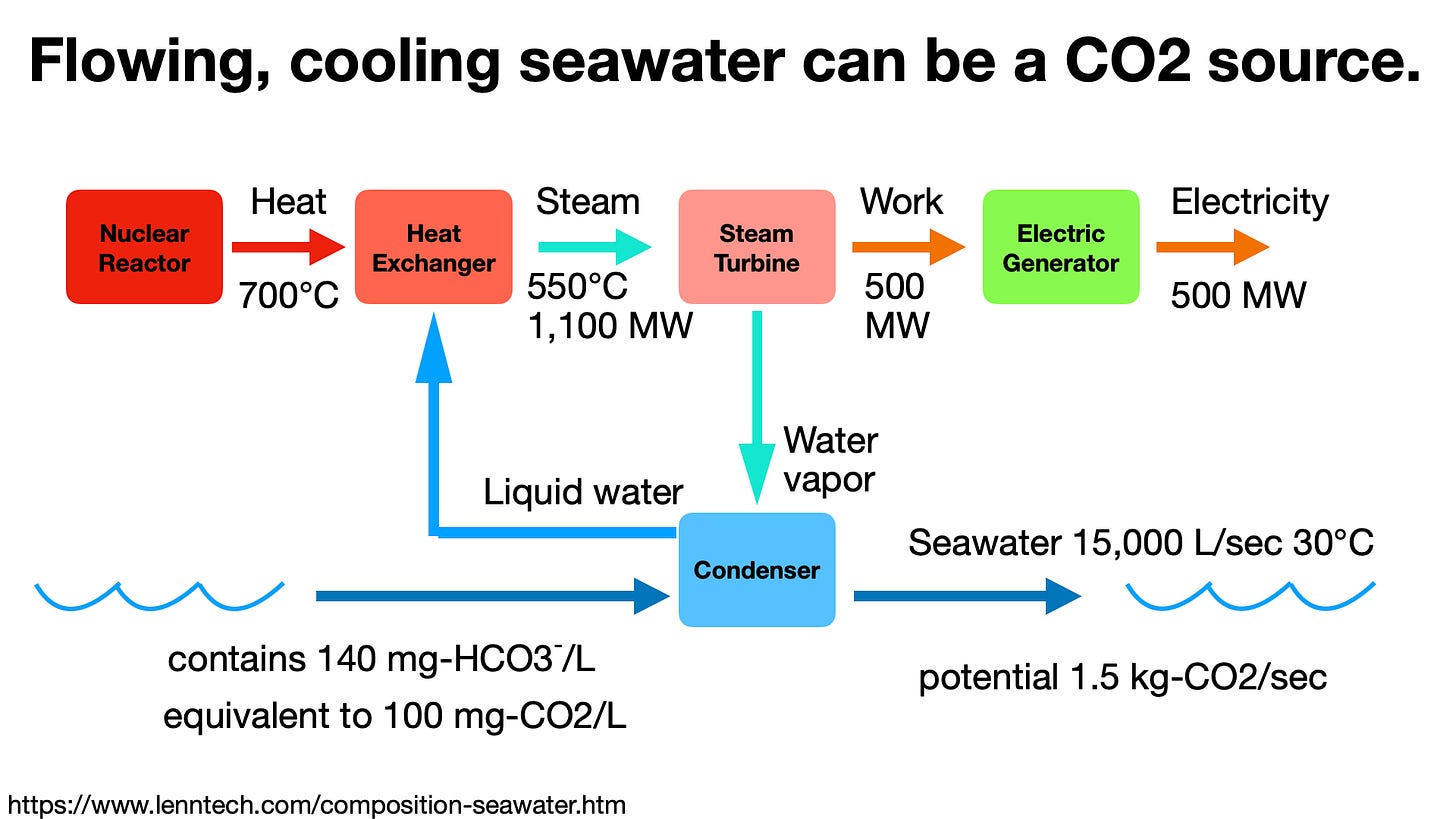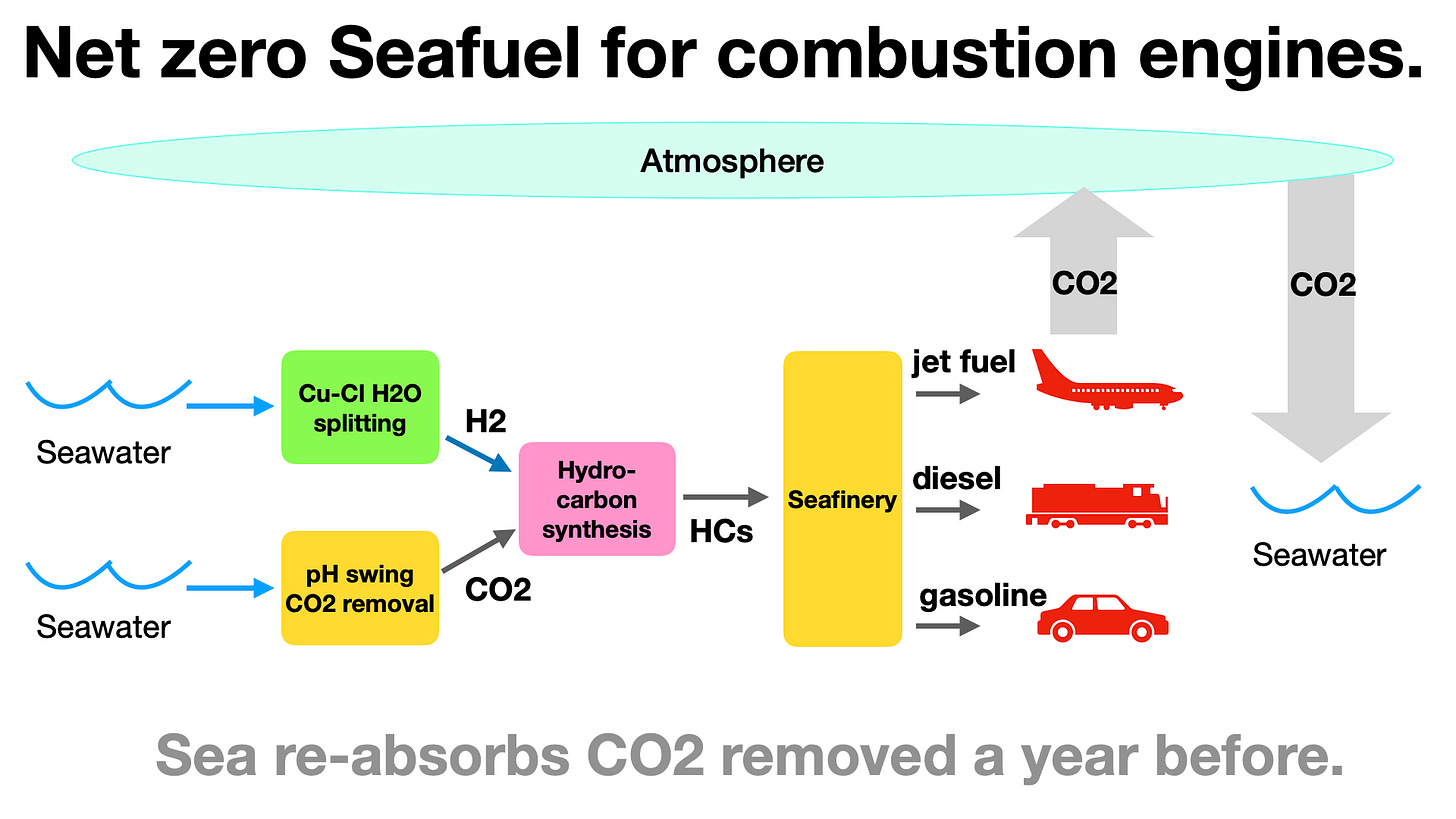Internal combustion engines (ICEs) power cars, trains, trucks and airplanes. They burn fuel and convert heat to useful work at efficiencies near 50%. They are reliable, affordable, long-lived. and fuelable from a well developed infrastructure. They are a backbone of civilization.
Electric vehicles (EVs) are in vogue for use as small to medium size automobiles. They are more costly than comparable ICE vehicles, but operating costs can be less than the ICE cars. EVs emit no CO2 when operating, but manufacturing them emits more because of materials needed for the large battery. The breakeven point is in the range of 50,000 to 100,000 kilometers.
The heavy EV batteries take up proportionately more room and cargo weight in larger cars and trucks, decreasing their haulage efficiency. Battery recharging times reduce EVs’ availability for service, especially for long distance commercial trucking.
Instead of using batteries, we can use nuclear power to create net-zero emissions fuel for today’s existing ICE vehicles, by capturing emitted CO2 in advance, then combining it with hydrogen split from water.
Nuclear power plants are now becoming in vogue, with over 60 under construction worldwide. None are now under construction nor planned in the US, because regulatory delays, rules, inexperience, and consequent costs have made new construction unprofitable. In developing countries, which need electricity for economic growth, costs can be less. New nuclear energy costs can indeed drop back to historical levels of 3¢/kWh-electric and 1¢/kWh-heat, now possible with advanced nuclear power.
Fission heat is converted to electricity in the pictured Steam Module, which contains the steam turbine and generator, along with condensers cooled by circulating seawater to convert spent steam back to pure water to be returned and heated to steam again. Alternatively the condenser heat might be used for heating cities, as in China and Siberia. Desalination is another potential application of nuclear heat.
It’s also possible to use both heat and electricity to split hydrogen from oxygen in water molecules. Hydrogen is key to manufacturing net-zero fuels for ICEs.
Here is a list of fuels for ICEs. The second column displays energy density, the amount of heat energy that can be obtained by burning, per unit of fuel mass. The third column is the volumetric energy density, the energy per unit of volume occupied by the fuel in the vehicle tank. Both densities are important to vehicle designers.
The units are kWh-thermal. One kWh-thermal is 1000 x 3600 J (joules). One joule is one watt-second.
That last table row isn’t quite comparable, because the battery’s 0.2 kWh of electric energy is more useful than 0.2 kWh of heat energy. Electric energy can directly perform useful, physical work. Typically 3 kWh of heat energy is required to produce 1 kWh of work energy. Conversion efficiency may range from 25% rising to 60% at high temperatures.
We do use lithium-ion batteries for light, short-range drones. However, the last row shows that lithium-ion batteries will never power commercial passenger aircraft, because they would have to carry 22 times more weight than the jet fuel used in today’s airplane turbine engine. [13 / 0.2 x 3 = 22] Jet fuel accounts for nearly half the weight of a long-distance aircraft on takeoff.
Biofuels are expensive because they use widely dispersed land areas for crops for energy sources. Global SAF consumption in 2022 was roughly 1,000 bbl/day. World airlines consume 5,600,000 bbl/day.
Today’s vehicle fuels are based on based on carbon. Each carbon atom can chemically link to four other atoms, in particular hydrogen. Such hydrocarbons are an efficient way to pack and transport hydrogen to be burned with oxygen to form H2O. The carbon atoms, too, are burned to form CO2.
Two simple fuels are shown on the left. The molecules on the right are examples of hydrocarbon molecules in mixtures composing today’s vehicle fuels,
A nuclear power plant is a huge machine optimized to provide low cost, reliable energy by converting fission heat to electricity. Even small fission power plants would be far too large to power most vehicles. Nuclear reactors do power 10,000 ton submarines and bigger naval vessels.
Burning a gallon of gasoline in an engine delivers 112 million joules, or 31 kWh of heat energy. At $3.00/gallon that’s about $0.10 per kWh of heat energy. Compared to the $0.01 per kWh of heat from nuclear power, we pay a premium of $0.09 per kWh for portability of our energy source.
We can use that $0.09/kWh fuel portability premium to pay for manufacturing hydrocarbon vehicle fuel out of air and water. CO2 is 0.04% of the atmosphere. Water is plentiful. New, molten salt reactor nuclear power plants can deliver both heat energy and electric energy inexpensively with refinery required reliability. Seaside refineries can provide the functions of separating carbon from CO2, hydrogen from H2O, and synthesizing the hydrocarbon fuels.
The 0.04% density of CO2 in the atmosphere is low. We can use the huge contact area with the ocean surface to harvest CO2 more efficiently. The link in the graphic above points to Sharifian et al’s excellent tutorial article on CO2 capture chemistry.
You may have already noticed that fizzy water pops out of a warm soda bottle, but more CO2 remains in it if the bottle comes out of your refrigerator.
Ocean currents such as the Gulf Stream distribute dissolved CO2 far and wide, not necessarily uniformly.
There is about 140x more CO2 per unit of volume in seawater than in the atmosphere. Extracting CO2 from seawater can be more efficient than from air.
This graphic above illustrates two possible states of seawater-air equilibrium, 280 and 560 ppm in air. For now just note the seawater is more acid with higher CO2.
The CO2 dissolved in water exists in three forms, at concentrations such as:
1% H2CO3 carbonic acid
90% HCO3(-) bicarbonate ion
9% CO3(2-) carbonate ion
More basic water (higher pH) favors higher concentration of carbonate, CO3(2-). More acidic water (lower pH) favors more concentration of carbonic acid, H2CO3. If we make the water sufficiently acidic, lowering the pressure will allow CO2 to gasify (H2CO3 —> H2O + CO2) and bubble out of the water. The idea will be to swing pH to acidic, extract CO2, then swing pH back. The next post will introduce pH swing.
A system to extract CO2 must have access to flowing seawater. Many power plants are cooled by pumping seawater to post-turbine water vapor condensers. The chart above graphs the cooling water flow of the Seabrook, New Hampshire, nuclear power plant, which generates 1.2 GW of electric power.
Above is a conceptual block diagram of an advanced, high temperature, molten salt reactor power plant. Incoming cooling water at 10°C cools the condenser to convert the turbine’s spent steam back to liquid water, The outbound, warmed seawater flows at 15,000 liters per second. Seawater contains about 140 milligrams per liter of bicarbonate. If converted to CO2 this seawater stream might provide 1.5 kilograms of CO2 per second. How this happens will be the topic of the next post.
CO2 is removed from flowing seawater by the pH swing process. Hydrogen is split from water using a thermal-electrolysis process. The CO2 and hydrogen are combined into hydrocarbons using existing commercial chemical engineering processes. The hydrocarbons are distilled into various commercial fuels as they are today in worldwide refineries. CO2 is emitted to the atmosphere as internal combustion engines burn the fuel in existing transportation vehicles, as now. Seawater absorbs CO2, putting back as much as was taken out. Seafuel burning accomplishes ‘carbon capture’ in advance. The fuel manufacturing and combustion process is net-zero for CO2.
The next post will deal with obtaining the needed CO2.


















My current concept on a more practical fuel than batteries is nuclear powered coal synfuel that I hear would have 30% less carbon than fossil gas
ChatGPT says coal gasification has about a $55 per barrel floor with these nuclear energy prices and fully synthetic Seafuel $100 per barrel. Both might be plausible options as many countries have indicated willingness to pay more by proposing electric mandates
Let's see 100 new nuclear plants delivering 3c/kWh being commissioned per year, then talk about other applications.
The global electricity markets are more than big enough to absorb huge amounts of new plants, and will hopefully grow as more countries find their ways out of poverty.